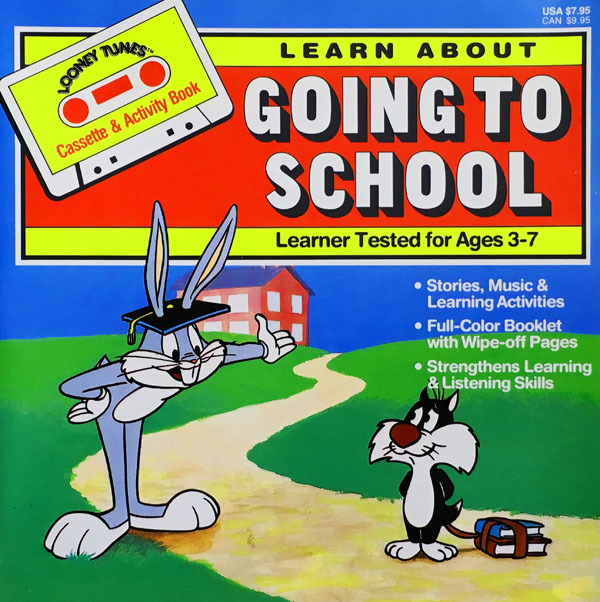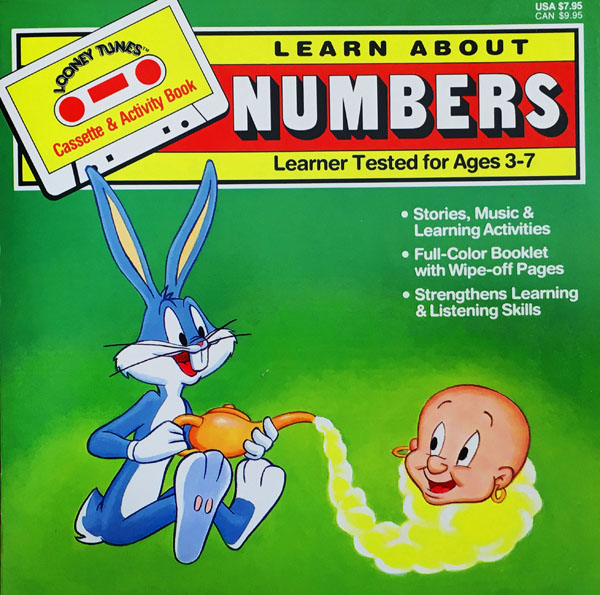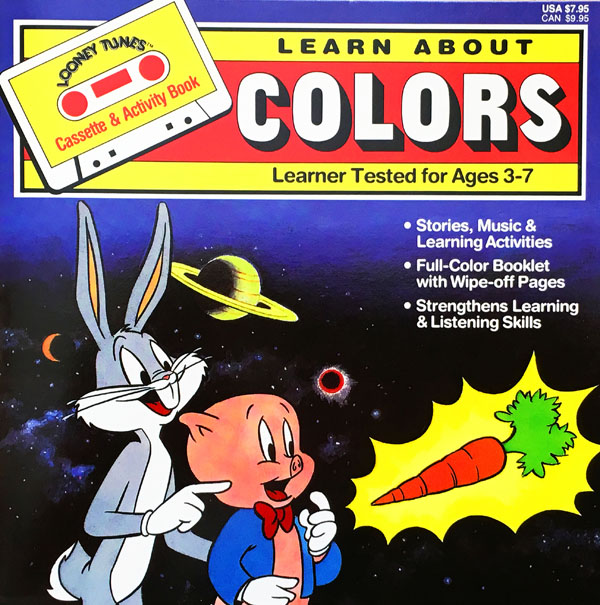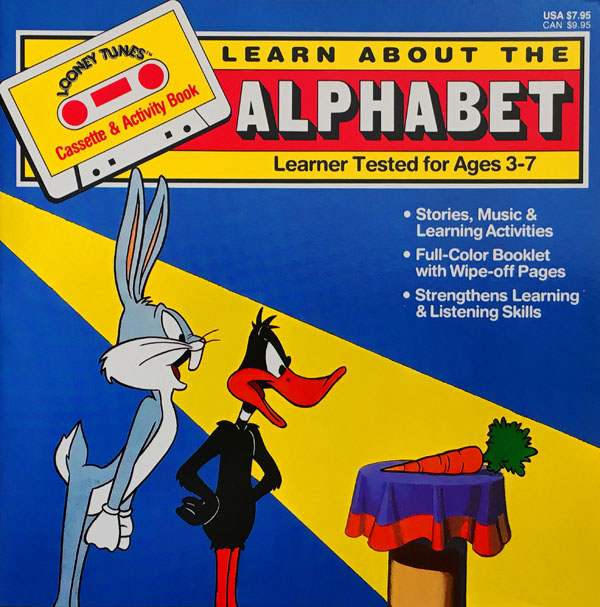Since Thursday is the 111th birthday of “The Man of a Thousand Voices,” let’s look at some of the later Looney Tunes recordings that Mel Blanc made especially for children.

LOONEY TUNES LEARN ABOUT… SERIES
With Voices by Mel Blanc
And Original Illustrations by Warner Brothers Artists
Warner Audio Publishing (Cassettes with Books)
Released in 1986. Producer: Family Radio Programming.
By the late twentieth century, Bugs Bunny had become enough of an icon through film, television and especially merchandising, that he was as easily acceptable as an instructor as an insurrectionist (though he taught millions of us about such things as classical music like The Barber of Seville). Mel Blanc had also reached legendary status with legions of fans.
 The Looney Tunes “Learn-Abouts” were certainly not the first time Warner Brothers characters appeared on educational materials of some kind or another, but these are of special note because all six packages are cognizant to some degree of the Warner character stable and, of course, they feature Blanc’s actual voices (in addition to two uncredited actors in supporting roles and an activity narrator).
The Looney Tunes “Learn-Abouts” were certainly not the first time Warner Brothers characters appeared on educational materials of some kind or another, but these are of special note because all six packages are cognizant to some degree of the Warner character stable and, of course, they feature Blanc’s actual voices (in addition to two uncredited actors in supporting roles and an activity narrator).
When these audio packages were released, Mel Blanc was doing voices for then-current series like Hanna-Barbera’s syndicated Jetsons reboot, The Flintstone Kids and DIC’s Heathcliff, but also running a thriving business with his son, Noel and accepting lifetime achievement awards on a regular basis. The Smithsonian had only recently presented a Mel Blanc exhibit and Bugs himself was honored with a star on the Hollywood Walk of Fame (Blanc received his in 1960).
Over the course of the six “Learn About” sets, Blanc plays almost every well-known Looney Tunes character–plus a few lesser-known ones, the presence of whom gives the (sadly uncredited) writing and art an air of authenticity and “extra-mile” quality. Each cassette offers an original story is presented on the first side, featuring Blanc and sometime one other actor. On the reverse sides, a narrator leads children through activities relating to the story as Bugs and friends make comments. The books, which have only a little bit of text, match the story and the activities.
The books have laminated pages that allow kids to draw on them with crayons and engage in the activities. Aside from a page turning signal, the stories can be enjoyed without books. If a book is lost, it cancels out the activities on side two of the cassette.
In terms of entertainment value in a broader sense—especially to Looney Tunes fans of all ages, the six book-and-cassette sets vary as to how they fall on a scale between being “preschooler education-focused” (which is one goal) and funny enough to be “Warner Bros. worthy” (which is the other). Submitted for your approval…

LEARN ABOUT GOING TO SCHOOL
Cassette #88371 / Running Time: 26 minutes.
There is little room for wacky hijinks in this subject, so the comedy is saved primarily for Sylvester. Bugs, who turns out to be Junior’s teacher, plays it completely straight here, offering a series of tips. Most interesting to historians is the classroom presence of lesser-seen characters like Chester the dog, Clyde Bunny and Hippety Hopper in addition to Tweety.

LEARN ABOUT SHAPES AND SIZES
Cassette #88374 / Running Time: 24 minutes.
This is actually the second recording in which Bugs competes with Cecil the Tortoise in a foot race. We explored the Capitol Records version of Bugs Bunny and the Tortoise here. The animated inspiration, Tortoise Beats Hare, was released in 1941.
Among Bugs’ distractions in this adaptation—which subtly work in the concepts of shapes and sizes into the tale, à la Sesame Street—are “the greedy type” Daffy Duck, who snags Bugs to sell him expensive running shoes, only to dump his mark when Bugs reveals he didn’t bring cash. Bugs also meets an unnamed female bunny who joins in a baseball game despite the comments of chauvinist pig Porky.

LEARN ABOUT NUMBERS
Cassette #88369 / Running Time: 24 minutes.
Bugs finds a magic lamp and inside is a genie, played not by Jim Backus, but Elmer Fudd. Even though Bugs gets more than three wishes, each has Twilight Zone consequences and Bugs never gets what he really wants. Interestingly, when he finds himself on a pirate ship about to walk the plank, the pirates are generic characters rather than Looney Tunes personnel. Yosemite Sam appears later in the “oh-no-not-again!” ending.

LEARN ABOUT COLORS
Cassette #88373 / Running Time: 25 minutes.
Bugs takes the place of Duck Dodgers in this space spoof, teaming with Porky in a trek through galaxy for carrots. The onboard computer has the voice of Marvin the Martian. The booklet includes an illustration of that “interesting” orange monster from (sometimes called Gossamer) from 1946’s Hair Raising Hare, though he’s not on the audio, There are lots of cute bits in this tale, including a purple planet ruled by Alexander the Grape and another planet made of chocolate that Porky never wants to leave.

LEARN ABOUT THE ALPHABET
Cassette #88369 / Running Time: 31 minutes.
In this game show in reminiscent of 1963’s The Million Hare, Daffy competes with Bugs and actually ends up winning a dollar bill, an apple a fish, an ostrich and an ice cream cone. Cameos include Yosemite Sam and Witch Hazel, who is not heard on the recording but appears in the book, and is called “Wilhelmina Witch” because the letter “W” is needed to serve the story. The twist comes when Daffy must decide whether to trade his prizes for “ownership of the whole world!”

SING-ALONG SONGS
Cassette #88372 / Running Time: 21 minutes.
The shortest of the cassettes is also the most densely-packed,because it is filled with songs and more characters than the other five sets. Bugs hosts “The Great Variety Show of the Century” but naturally Daffy thinks he is the star and interferes with each performer’s song or routine.
 The songs are mostly public domain children’s nursery songs, including “Eensie Weensie Spider” sung by Porky; Hickory Dickory Dock by Tweety and Sylvester; “Row, Row, Row Your Boat” by Elmer Fudd; “Comin’ ‘Round the Mountain” by Yosemite Sam (with some “meep-meeps” from the Road Runner); and “Twinkle, Twinkle Little Star” as a finale by the cast.
The songs are mostly public domain children’s nursery songs, including “Eensie Weensie Spider” sung by Porky; Hickory Dickory Dock by Tweety and Sylvester; “Row, Row, Row Your Boat” by Elmer Fudd; “Comin’ ‘Round the Mountain” by Yosemite Sam (with some “meep-meeps” from the Road Runner); and “Twinkle, Twinkle Little Star” as a finale by the cast.
Daffy also does a medley of “It’s Raining, “It’s Pouring,” “Rain, Rain, Go Away” and a little bit of “Singing in the Rain,” which is not public domain. Neither are the familiar Warner Bros. cartoon staples “Powerhouse” and “Merrily We Roll Along,” which are heard very briefly as well. Surely the fees for playing even a little of those three melodies should have bumped up the budget of Sing-Along Songs.
In addition, Sing-Along Songs required original keyboard work, requiring more studio time. The other “Learn About” stories relied on production music and a little keyboard here and there.
The extra effort and budget that went into Sing-Along Songs pays off for Warner Bros. fans because the results doesn’t come across as curricular as the other Learn-Abouts,” although it is just as educational, perhaps more so. Music has always been a great teacher, and with the Looney Tunes characters, it’s a powerhouse.


 GREG EHRBAR is a freelance writer/producer for television, advertising, books, theme parks and stage. Greg has worked on content for such studios as Disney, Warner and Universal, with some of Hollywood’s biggest stars. His numerous books include Mouse Tracks: The Story of Walt Disney Records (with Tim Hollis). Visit
GREG EHRBAR is a freelance writer/producer for television, advertising, books, theme parks and stage. Greg has worked on content for such studios as Disney, Warner and Universal, with some of Hollywood’s biggest stars. His numerous books include Mouse Tracks: The Story of Walt Disney Records (with Tim Hollis). Visit 





















































I just wish they had uysed the 1940s duck
Is the female Bunny suppose to be Honey Bunny?
How Come the Links got taken Down?